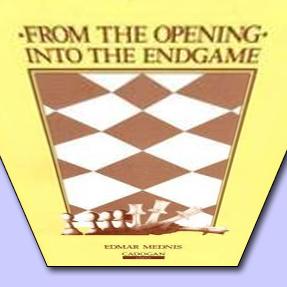
The French Endgame
A distinctive structure arises from the French Defense, featuring White's space advantage and Black's restricted light-squared bishop. Against this, Black hopes for counterplay via the pawn break ...f6 and queenside counterplay on the c-file and on the queenside squares such as a4 and b4.
This position arose in the game Keres-Flores, from the Buenos Aires Olympiad, 1939. Keres's vastly weaker opponent had just played - in a normal position as Black in the French Defense - ...Bb4+ followed by ...Bxd2+, ...Qb4, and ...Qxd2+.
Apparently he was hoping to make a draw with his famous opponent by trading queens early on. It is important to understand that this is not a good idea! Not only is cravenly playing for a draw bad psychologically (one who is fighting only for a draw often avoids active play when such play is simply necessary), but also here Black has made many concessions purely in order to effect the exchange of queens. His entire exchanging operation has lost many tempi, since he moved each piece multiple times before exchanging them, while White's recaptures improved his development. Black has also made the positional concession of exchanging dark-squared bishops when his fixed central pawns are located on light squares. Thus he is left with his bad light-squared bishop and weakened dark squares.
Nowadays I think most weaker masters would not play in such a way - but this was 1939. In some cases, the favored player could disturbed by a weaker opponent trading many pieces, even when the stronger player keeps some slight objective advantage - mostly if it becomes the type of ending where one mistake could lead the game the game to become very drawish. But this is not such a position. In particular, the position is closed and there isn't much chance that there will be many more simplifications.

White has a clear advantage in the above position, and I don't think any strong player, regardless of style, would be unhappy to play this endgame. But Keres's technique is very instructive, and anyone wanting to see how to play this type of position should pay close attention.
He has two main objectives:
- restrain Black's counterplay;
- make progress somehow, avoiding a potential fortress.
Let's see how Paul Keres did this. The game began as follows:
Black is hoping to gain counterplay in a standard pattern, typical of such French positions - ...Bd7, ...Kd7, ...Rfc8, ...a5-a4, etc. It seems easier for Black to play, but let's see how Keres first stops Black's counterplay while preparing his own action.
Black's play on the queenside has been rendered harmless. White gave up the b4 square, but that can hardly be used to do any damage to him. Meanwhile, Black can be the one to occupy the only open file, the c-file, with his rook - but this gives him nothing since there are no invasion squares there. The next step of White's plan is to create some of his own play on the kingside. He needs to prevent chances of Black holding a draw by creating a fortress.
Black has been induced to create permanent weaknesses on the kingside. Now White must find a way to attack them. For this, Keres uses a nice and instructive maneuver.
Finally White has won a pawn. What follows is the realization of the advantage, while preventing any counterplay.
A very simple but elegant game, between players of two very different classes. Nevertheless, an instructive example of how to restrict Black's counterplay in this typical kind of position, from which I think amateur players could learn a lot.
RELATED STUDY MATERIAL
- Explore the French Defense;
- Watch the videos Greatest Chess Minds: Paul Keres Part 1 & Part 2;
- Play the opening better than Flores! Check out Chess Mentor Intermediate: Openings;
- Sharpen your tactics.






